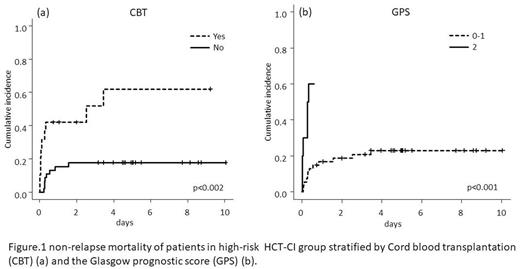Abstract
Introduction
The Hematopoietic Cell Transplantation-specific Comorbidity Index (HCT-CI), which is based on the function of main organs, is a useful tool for pre-transplant risk assessments. The HCT-CI has been widely applied for determining treatment strategies for patients with hematological diseases. Due to high non-relapse mortality (NRM), patients categorized in the high-risk HCT-CI group require careful consideration regarding allogeneic HCT. As the c-estimate of the HCT-CI is approximately 0.65, further stratification methods are needed when deciding on allogeneic HCT for patients in the high-risk HCT-CI group.
Some biomarkers, such as serum albumin (Alb), C-reactive protein (CRP) and pre-transplant serum ferritin (SF), were independently reported to be useful prognostic indicators for allogeneic HCT. Moreover, the Glasgow prognostic score (GPS), which assesses the combined CRP and Alb, was reported to predict the survival of patients with solid organ malignancies independently of chemo/radiotherapy or stages of cancer. It may also be a useful tool for prediction of prognosis with allogeneic HCT.
Aims
To identify further prognostic factors for stratification of patients in the high-risk HCT-CI group undergoing allogeneic HCT.
Patients and methods
We analyzed 189 patients with hematological disease who underwent allogeneic HCT between 2006 and 2016 at our facility. We evaluated prognostic factors for NRM as follows: the HCT-CI (high-risk), the GPS (score 2), SF (>1000 ng/dl), age (>40), sex (female to male), conditioning regimens (myeloablative) and donor sources (cord blood or others, matched related or not). The GPS was constructed as previously described. Briefly, patients with both an elevated CRP (>1 mg/dl) and hypoalbuminemia (<3.5 g/dl) were allocated a score of 2. Patients in whom only one of these biochemical abnormalities was present were allocated a score of 1. Patients in whom neither of these abnormalities was present were allocated a score of 0. The score of the HCT-CI and values of CRP, Alb and SF were collected within 28 days before allogeneic HCT.
Results
Seventy-two patients were categorized in low-, 44 patients were categorized in intermediate- and 54 patients were categorized in high-risk HCT-CI groups in our study. The patients in the high-risk HCT-CI group had a poor prognosis on univariate analysis. The one-year NRM of patients in the low/intermediate- and high-risk HCT-CI groups were 13.3% and 23.5%, respectively (p=0.027). We evaluated further prognostic factors for patients in the high-risk HCT-CI group. In the univariate analysis, cord blood and GPS score of 2 were extracted as poor prognostic factors. The one-year NRM of patients with non-cord blood or cord blood grafts were 15.6% and 42.1%, respectively (p<0.002). The one-year NRM of patients with a GPS score of 0-1 or 2 were 16.7% vs NA, respectively (p<0.001). In the multivalent analysis, cord blood, GPS score of 2 and >40 years of age were found to be independent poor prognostic factors for NRM (cord blood: hazard ratio 7.47, p=0.009, GPS score of 2: hazard ratio 4.76, p=0.012, >40 years of age: hazard ratio 3.47, p=0.015). Even in the high-risk HCT-CI group, patients with a GPS score of 0-1 or with grafts other than cord blood exhibited a similar NRM in low/intermediate-risk HCT-CI group. Moreover, these were not poor prognostic factors for patients in the low/intermediate-risk HCT-CI group.
Conclusion
Cord blood, the GPS (score 2) and age (>40) were extracted as poor prognostic factors for patients in the high-risk HCT-CI group. For adaptation of allogeneic HCT for patients in the high-risk HCT-CI group with one or more of these factors, NRM should be carefully monitored.
No relevant conflicts of interest to declare.
Author notes
Asterisk with author names denotes non-ASH members.


